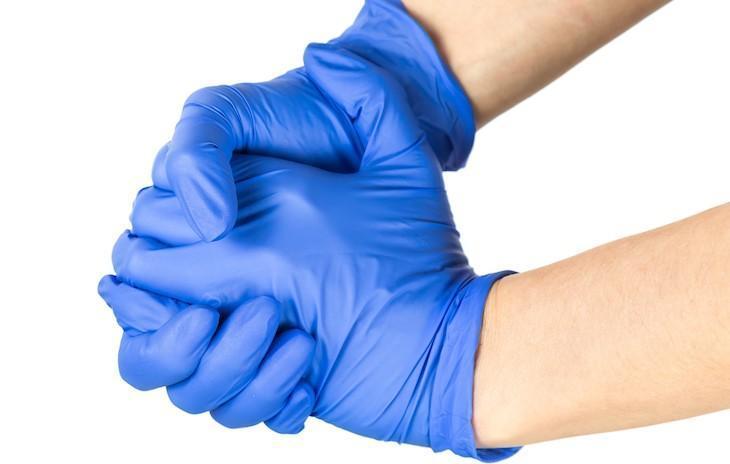View the complete, original article at: blog.monouso-direct.com
The increase in the number of cases of coronavirus (Covid-19) has increased the concern for maintaining adequate hygiene to avoid possible contagion. In this sense, disposable gloves, such as vinyl gloves, are an effective protection measure against the virus and are also part of personal protective equipment (PPE) against Covid-19. Protective gloves against biological agents must guarantee impermeability, maximum flexibility and high sensitivity in order to enable them to be used in all types of work.
There are several types of disposable gloves on the market today to meet different needs. The level of protection, comfort or durability are factors that vary between glove types, including latex gloves, nitrile gloves and vinyl gloves.
- What are vinyl gloves
- What vinyl gloves are used for
- Powdered or dust-free disposable gloves?
- Recommendations for the use of vinyl gloves
Step 1: Choose the right glove
Step 2: Check the condition of the glove
Step 3: Wash your hands
Step 4: Wear the gloves
Step 5: Throw away the gloves after use
What are vinyl gloves
Vinyl gloves are a type of disposable glove derived from synthetic PVC resins, so they do not present the same allergy risk as latex or natural rubber alternatives, making them an attractive option for food preparation and employee safety.
Vinyl is less elastic than nitrile and latex, providing a looser fit and a soft, comfortable feel. In addition, this material offers greater permeability and less resistance than nitrile or latex gloves.
Vinyl gloves have the following features:
- 100% latex free.
- Elastic.
- Resistant to chemicals: strong acids and bases, salts, other water solutions and alcohols
- Resistant to food, water, oils and petroleum.
What vinyl gloves are used for
Vinyl gloves are recommended for short duration tasks and with a high frequency of change, such as orthodontics, domestic use, food industry or residential use for cleaning patients.
This type of glove is mainly used in the food industry to ensure compliance with hygiene standards. Their looser fit makes them ideal for those working in food retailing, allowing people to remove their gloves quickly and easily when dealing with customers. In addition, the resistance of vinyl gloves to oils makes them an ideal protection element for the hotel industry.
Vinyl gloves also provide protection during general cleaning use, such as changing bedding or laundry. These gloves are particularly suitable for use in healthcare, medical or dental environments, as they comply with the standard for medical protective gloves (EN 455) and enhance the protection of the patient and user against any biological and chemical hazards. The vinyl gloves meet all requirements for microbiological safety testing and low chemical risk (EN 374-2 and EN 374-3).
Powdered or dust-free disposable gloves?
Most of our vinyl gloves are available in both powdered and non-powdered varieties. Powdered gloves are covered with a light layer of basic cornstarch powder that helps to put the glove on and also to absorb perspiration. Some users find this beneficial and increases comfort during prolonged use. In clinical environments, powder-free gloves may be preferable to minimise the risk of cross-contamination that occurs through natural dispersal of the powder.
The powder used in vinyl gloves, to ensure that they are easy to put on and take off, is cornstarch. This ensures that the hands can fit into the gloves without any problems, but some people find that they suffer from irritation caused by friction of the powder on the glove and therefore dust-free varieties are more commonly chosen.
Recommendations for the use of vinyl gloves
Disposable gloves, such as vinyl gloves, offer excellent protection against contamination, provided they are worn and removed properly. To get the most out of wearing gloves, we recommend that you follow the instructions below:
Step 1: Choose the right glove
Choose a glove that fits well and is designed for the intended use.
Step 2: Check the condition of the glove
Check each glove for tears and punctures.
Step 3: Wash your hands
Gloves should never replace proper hand washing or disinfection. Therefore, it is advisable to wash your hands before and after putting on the gloves.
Step 4: Wear the gloves
Put on gloves. While wearing disposable gloves, do not touch telephones, doorknobs or similar.
Step 5: Throw away the gloves after use
Never wash or reuse disposable gloves. Gloves should be used when necessary and for as long as necessary because abuse of gloves gives false security and increases cross-contamination.
In any of the following situations, be sure to remove your gloves, wash your hands and put on a new pair of gloves:
- Between patients or tasks.
- When the gloves become contaminated.
- When the gloves become contaminated.
- When the gloves are broken.
- When the gloves have been worn for four consecutive hours.
- After sneezing, coughing, or touching your hair or face
It is important to remove the gloves correctly and follow proper technique, such as the one shown below, to avoid contamination from the outside.
In short, vinyl gloves can be worn once and disposed of and are an ideal choice for cleaning controls or single-use testing, where latex could cause an allergic reaction. They come in a powdered version for easy fitting and some are even sterilized for infection control.



comments (0)